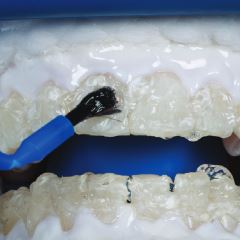Porcelain veneers transform smiles. A skilled cosmetic dentist and ceramist can manipulate porcelain to mimic the color and translucence of natural teeth. Advanced dental technology has introduced ultra-thin veneers. Which type of veneers should you choose?
Should You Choose Ultra-thin or Traditional Veneers?
Whether you choose ultra-thin or traditional veneers depends on your case, the condition of your teeth, and your dentist’s recommendations. We explain some factors that may influence your and your dentist’s decision.
Traditional Porcelain Veneers
Traditional veneers have the following characteristics:
- About .5 millimeter thick
- Require preparation of your natural teeth so they fit correctly and will not look bulky
- 0.3 to 0.5 millimeters of the front surface of a tooth is removed to prepare it for a veneer
Ultra-Thin Veneers
Ultra-thin veneers have the following characteristics:
- About .3 millimeter thick
- Can be bonded to your teeth without preparation
- Cosmetic dentists strive to remove a minimal amount of a tooth’s front surface
What Do Ultra-thin and Traditional Veneers Have in Common?
Ultra-thin and traditional veneers have several things in common:
- Custom-made in a dental lab
- Match the characteristics of your natural teeth, so in the hands of a skilled cosmetic dentist, people will think your veneers are your natural teeth
- Stain-resistant
- Can last 15-20 years if you take diligent care of them and have them maintained by a trained cosmetic dentist
Which Should You Choose?
Schedule an appointment with a skilled cosmetic dentist. They can determine which type of veneers will give you the best results based on the condition of your teeth, the shape, position, and size of your teeth, and the results you want to achieve. You should not insist on either traditional or ultra-thin veneers. A cosmetic dentist will also preserve as much tooth structure as possible yet produce natural-looking results. The dentist will bond your veneers to ensure they look natural and are durable.
Many patients find it helpful to schedule at least two consultations before making decisions about porcelain veneers. Below are a few tips for scheduling your consultation:
- Select experienced cosmetic dentists, preferably accredited, who have advanced, post-graduate training.
- Look for a smile gallery on each dentist’s website and find photos of patients who received porcelain veneers.
- Ask the dentist how many porcelain veneer cases they have completed.
- Compare the recommendations, treatment plan, and costs of each dentist.
- Look for patient reviews on the dentist’s work.
What Can You Expect?
After the consultation, if you are interested in porcelain veneers, you can expect the following:
- An exam
- Digital x-rays
- A smile design that includes your preferences and considers your facial features to ensure natural-looking results
If you want a bright smile with porcelain veneers, your cosmetic dentist must whiten your natural teeth first. It will ensure that your veneers match the color of your teeth.
Miranda Lacy, DDS, a Plano, Texas, female dentist sponsors this post.
